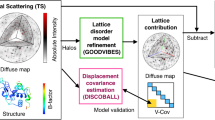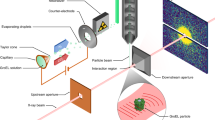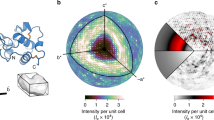Abstract
Using a manifold-based analysis of experimental diffraction snapshots from an X-ray free electron laser, we determine the three-dimensional structure and conformational landscape of the PR772 virus to a detector-limited resolution of 9 nm. Our results indicate that a single conformational coordinate controls reorganization of the genome, growth of a tubular structure from a portal vertex and release of the genome. These results demonstrate that single-particle X-ray scattering has the potential to shed light on key biological processes.
This is a preview of subscription content, access via your institution
Access options
Access Nature and 54 other Nature Portfolio journals
Get Nature+, our best-value online-access subscription
$29.99 / 30 days
cancel any time
Subscribe to this journal
Receive 12 print issues and online access
$259.00 per year
only $21.58 per issue
Buy this article
- Purchase on Springer Link
- Instant access to full article PDF
Prices may be subject to local taxes which are calculated during checkout




Similar content being viewed by others
References
Neutze, R., Wouts, R., van der Spoel, D., Weckert, E. & Hajdu, J. Potential for biomolecular imaging with femtosecond X-ray pulses. Nature 406, 752–757 (2000).
Breedlove, J.R. Jr. & Trammell, G.T. Molecular microscopy: fundamental limitations. Science 170, 1310–1313 (1970).
Solem, J.C. & Baldwin, G.C. Microholography of living organisms. Science 218, 229–235 (1982).
Miao, J., Charalambous, P., Kirz, J. & Sayre, D. Extending the methodology of X-ray crystallography to allow imaging of micrometre-sized non-crystalline specimens. Nature 400, 342–344 (1999).
Fung, R., Shneerson, V., Saldin, D.K. & Ourmazd, A. Structure from fleeting illumination of faint spinning objects in flight. Nat. Phys. 5, 64–67 (2009).
Loh, N.T. & Elser, V. Reconstruction algorithm for single-particle diffraction imaging experiments. Phys. Rev. E 80, 026705 (2009).
Seibert, M.M. et al. Single mimivirus particles intercepted and imaged with an X-ray laser. Nature 470, 78–81 (2011).
Hantke, M.F. et al. High-throughput imaging of heterogeneous cell organelles with an X-ray laser. Nat. Photonics 8, 943–949 (2014).
Kuhn, R.J., Dowd, K.A., Beth Post, C. & Pierson, T.C. Shake, rattle, and roll: impact of the dynamics of flavivirus particles on their interactions with the host. Virology 479-480, 508–517 (2015).
Mateu, M.G. Assembly, stability and dynamics of virus capsids. Arch. Biochem. Biophys. 531, 65–79 (2013).
Xu, R. et al. Single-shot three-dimensional structure determination of nanocrystals with femtosecond X-ray free-electron laser pulses. Nat. Commun. 5, 4061 (2014).
Ekeberg, T. et al. Three-dimensional reconstruction of the giant mimivirus particle with an x-ray free-electron laser. Phys. Rev. Lett. 114, 098102 (2015).
Loh, N.D. et al. Cryptotomography: reconstructing 3D Fourier intensities from randomly oriented single-shot diffraction patterns. Phys. Rev. Lett. 104, 225501 (2010).
Moore, P.B. How should we think about the ribosome? Annu. Rev. Biophys. 41, 1–19 (2012).
Changeux, J.P. & Edelstein, S. Conformational selection or induced fit? 50 years of debate resolved. F1000 Biol. Rep. 3, 19 (2011).
Ye, L., Van Eps, N., Zimmer, M., Ernst, O.P. & Prosser, R.S. Activation of the A2A adenosine G-protein-coupled receptor by conformational selection. Nature 533, 265–268 (2016).
Yu, I.M. et al. Structure of the immature dengue virus at low pH primes proteolytic maturation. Science 319, 1834–1837 (2008).
Henrich, B. et al. The adaptive gain integrating pixel detector AGIP a detector for the European XFEL. Nucl. Instrum. Methods Phys. Res. A 633, S11–S14 (2011).
Jarzynski, C. Nonequilibrium equality for free energy differences. Phys. Rev. Lett. 78, 2690–2693 (1997).
Jarzynski, C. Equilibrium free energy differences from nonequilibrium measurements. Phys. Rev. E 56, 5018–5035 (1997).
Crooks, G.E. Path-ensemble averages in systems driven far from equilibrium. Phys. Rev. E 61, 2361 (2000).
Pressé, S. Principles of maximum entropy andn maximum caliber in statistical physics. Rev. Mod. Phys. 85, 1115–1141 (2013).
Schwander, P., Fung, R. & Ourmazd, A. Conformations of macromolecules and their complexes from heterogeneous datasets. Phil. Trans. R. Soc. Lond. B 369, 20130567 (2014).
Dashti, A. et al. Trajectories of the ribosome as a Brownian nanomachine. Proc. Natl. Acad. Sci. USA 111, 17492–17497 (2014).
Frank, J. & Ourmazd, A. Continuous changes in structure mapped by manifold embedding of single-particle data in cryo-EM. Methods 100, 61–67 (2016).
Reddy, H.K.N. et al. Coherent soft X-ray diffraction imaging of coliphage PR772 at the Linac coherent light source. Sci. Data 4, 170079 (2017).
Hosseinizadeh, A., Dashti, A., Schwander, P., Fung, R. & Ourmazd, A. Single-particle structure determination by X-ray free-electron lasers: possibilities and challenges. Struct. Dyn. 2, 041601 (2015).
Hosseinizadeh, A. et al. High-resolution structure of viruses from random diffraction snapshots. Phil. Trans. R. Soc. Lond. B 369, 20130326 (2014).
Scheres, S.H. & Chen, S. Prevention of overfitting in cryo-EM structure determination. Nat. Methods 9, 853–854 (2012).
Peralta, B. et al. Mechanism of membranous tunnelling nanotube formation in viral genome delivery. PLoS Biol. 11, e1001667 (2013).
Santos-Pérez, I. et al. Membrane-assisted viral DNA ejection. Biochim. Biophys. Acta 1861, 664–672 (2017).
Incardona, N.L. & Kaesberg, P. A pH-induced structural change in bromegrass mosiac virus. Biophys. J. 4, 11–21 (1964).
Speir, J.A., Munshi, S., Wang, G., Baker, T.S. & Johnson, J.E. Structures of the native and swollen forms of cowpea chlorotic mottle virus determined by X-ray crystallography and cryo-electron microscopy. Structure 3, 63–78 (1995).
Ayyer, K., Lan, T.Y., Elser, V. & Loh, N.D. Dragonfly: an implementation of the expand-maximize-compress algorithm for single-particle imaging. J. Appl. Crystallogr. 49, 1320–1335 (2016).
Frank, J. Three-Dimensional Electron Microscopy of Macromolecular Assemblies 2nd edn. (Oxford University Press, 2006).
Coifman, R.R. et al. Geometric diffusions as a tool for harmonic analysis and structure definition of data: diffusion maps. Proc. Natl. Acad. Sci. USA 102, 7426–7431 (2005).
Giannakis, D. & Majda, A.J. Nonlinear Laplacian spectral analysis for time series with intermittency and low-frequency variability. Proc. Natl. Acad. Sci. USA 109, 2222–2227 (2012).
Giannakis, D., Schwander, P. & Ourmazd, A. The symmetries of image formation by scattering. I. Theoretical framework. Opt. Express 20, 12799–12826 (2012).
Schwander, P., Giannakis, D., Yoon, C.H. & Ourmazd, A. The symmetries of image formation by scattering. II. Applications. Opt. Express 20, 12827–12849 (2012).
White, T.A. CrystFEL: a software suite for snapshot serial crystallography. J. Appl. Crystallogr. 45, 335–341 (2012).
Fienup, J.R. Phase retrieval algorithms: a comparison. Appl. Opt. 21, 2758–2769 (1982).
Coifman, R.R., Shkolnisky, Y., Sigworth, F.J. & Singer, A. Graph Laplacian tomography from unknown random projections. IEEE Trans. Image Process. 17, 1891–1899 (2008).
Marchesini, S. et al. X-ray image reconstruction from a diffraction pattern alone. Phys. Rev. B 68, 140101 (2003).
Dashti, A., Komarov, I. & D'Souza, R.M.D. Efficient computation of k-nearest neighbour graphs for large high-dimensional data sets on GPU clusters. PLoS One 8, e74113 (2013).
Acknowledgements
We acknowledge valuable discussions with H. Chapman, E. Lattman, J. Spence and I. Vartaniants. The research conducted at University of Wisconsin–Milwaukee was supported by the US Department of Energy, Office of Science, Basic Energy Sciences, under contract DE-SC0002164 (A.O., algorithm design and development) and by the US National Science Foundation (NSF) under contract STC 1231306 (A.O., numerical trial models and data analysis; M.S., data analysis) and under contract number 1551489 (A.O., underlying analytical models). The research at Arizona State University was supported by the NSF under contract STC 1231306 (B.G.H.). Use of the Linac Coherent Light Source (LCLS), SLAC National Accelerator Laboratory, was supported by the US Department of Energy, Office of Science, Office of Basic Energy Sciences under contract DE-AC02-76SF00515.
Author information
Authors and Affiliations
Contributions
A.H.: algorithmic design, data preprocessing, single-particle hit finding, orientation and structural recovery, preparation of paper. G.M.: conformational analysis, preparation of paper. J.C.: conformational analysis and validation, preparation of paper. P.S.: experimental and algorithmic design, code development, data preprocessing, data analysis, experiments at LCLS, preparation of paper. A.D., R.S. and R.F.: data-analytical contributions. M.S.: analysis of results, preparation of paper. C.H.Y.: experimental design, data collection. B.G.H.: sample selection, preparation and characterization, experiments at LCLS, preparation of paper. G.J.W.: planning and execution of experiment and discussions of data and analysis. A.A.: experimental design, data collection, preparation of paper. A.O.: experimental and algorithmic design, data analysis and interpretation, preparation of paper.
Corresponding author
Ethics declarations
Competing interests
The authors declare no competing financial interests.
Integrated supplementary information
Supplementary Figure 1 2D snapshots obtained by direct phasing of individual diffraction snapshots.
Each row shows five representative snapshots assigned to an extreme value of the conformational parameter τ. Note the reduction in the projected inner density between the two rows. (Rainbow color code, with dark red corresponding to the highest density.)
Supplementary Figure 2 Reliability of the reconstructed diffraction volume.
R-split as a function of the magnitude of the scattering vector q, indicating reliable reconstruction up to the detector-limited resolution of 9 nm. The analysis was performed by random splitting, without substitution, of the 37,550 snapshots into two disjoint datasets.
Supplementary Figure 3 Spatial resolution of 3D density.
Fourier Shell Correlation (FSC) vs. the magnitude of the scattering vector q obtained from splitting the 37,550 snapshots into two random disjoint subsets. The resolution is limited to 9 nm by the detector geometry.
Supplementary Figure 4 Spherically averaged radial densities of 3D structures obtained without imposing icosahedral symmetry.
The conformational coordinate ranges from 0 (black curve) to 1 (red curve). Averages (circles) and standard deviations (error bars) pertain to twenty 3D iterative phasing calculations using all 37,550 single-particle snapshots. Spline fits are guides to the eye.
Supplementary Figure 5 A representative experimental XFEL diffraction snapshot of the PR772 virus before and after preprocessing.
(a) A raw snapshot. (b) Same snapshot after background correction. The dark horizontal line in each snapshot is due to the gap between the two detector panels. Intensity is shown in the rainbow color code, with red corresponding to the highest intensity.
Supplementary Figure 6 Diffusion map manifolds formed by experimental XFEL diffraction snapshots of the PR772 virus.
(a) Manifold obtained by embedding 135,375 preprocessed XFEL snapshots (“hits”). (b) Distribution of single- and multi-particle snapshots on the same manifold. The general parabolic shape stems from changes in the incident beam intensity intersecting the particles. (c) Manifold of single-particle snapshots after outlier removal. A total of 37,550 single-particle snapshots were extracted by this analysis.
Supplementary Figure 7 Comparison of icosahedral Wigner D functions with diffusion map manifolds obtained from simulated and experimental diffraction snapshots.
(a) Icosahedral Wigner D-functions sampled in 30,000 randomly selected orientations. (b) DM eigenfunctions obtained from 30,000 simulated, noise-free snapshots of an icosahedral capsid. (c) Manifold from 37,550 simulated snapshots of an icosahedral capsid with experimental signal-to-noise ratio (SNR) and detector gap. (d) Manifold from 37,550 experimental single-particle PR772 snapshots. (e) Eigenvalue spectrum for an icosahedral capsid simulated at the experimental SNR. (f) Eigenvalue spectrum for the PR772 virus.
Supplementary Figure 8 Diffusion map eigenvalue spectra for experimental and simulated diffraction snapshots of PR772 virus.
(a) Spectrum for 37,550 single-particle experimental snapshots of PR772 virus. (b) Spectrum resulting from the same number of simulated snapshots of an icosahedral capsid stretched by 10% along one 5-fold axis. Note the differences between the eigenvalue spectra.
Supplementary information
Supplementary Text and Figures
Supplementary Figures 1–8 and Supplementary Note (PDF 1339 kb)
Life Sciences Reporting Summary
Life Sciences Reporting Summary (PDF 160 kb)
Supplementary Data
Single-particle indices (XLSX 1153 kb)
3D conformational movie with imposed icosahedral symmetry.
Evolution of the 3D structure of the PR772 virus, and the occupancy along the dominant conformational reaction coordinate. These results were obtained assuming icosahedral symmetry. (MOV 800 kb)
3D conformational movie without imposing icosahedral symmetry.
Evolution of the 3D structure of the PR772 virus, and the occupancy along the conformational reaction coordinate without imposing icosahedral symmetry. Note the protrusion of a tubular structure, and the concentration of the genome toward the tube. (MOV 418 kb)
Rights and permissions
About this article
Cite this article
Hosseinizadeh, A., Mashayekhi, G., Copperman, J. et al. Conformational landscape of a virus by single-particle X-ray scattering. Nat Methods 14, 877–881 (2017). https://doi.org/10.1038/nmeth.4395
Received:
Accepted:
Published:
Issue Date:
DOI: https://doi.org/10.1038/nmeth.4395
This article is cited by
-
Structural biology is solved — now what?
Nature Methods (2022)
-
The case for data science in experimental chemistry: examples and recommendations
Nature Reviews Chemistry (2022)
-
An encryption–decryption framework to validating single-particle imaging
Scientific Reports (2021)
-
Science in the age of machine learning
Nature Reviews Physics (2020)
-
Retrieving functional pathways of biomolecules from single-particle snapshots
Nature Communications (2020)



